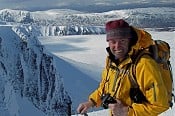Hi - this is my first post so hope I'm not breaking or contravening any forum rules in this post.
My post is in regards to high altitude trekking and AMS (Acute Mountain Sickness). I am a 47-year-old male. I keep myself in good shape and regard myself as being physically fit.
In October (2017) I set out to trek to Everest Base Camp in Nepal. Five years previous to this trek I had completed the Annapurna Circuit over 17 days. The Annapurna Circuit was amazing. Starting at Besi Sahar and ending at Nayapul, the Annapurna Circuit rises to 5416m as you cross the Thorong La Pass. I spent 3 days acclimatising in Manang (3500m) and completed the circuit without incident. The trek was awe-inspiring and I loved every minute of it.
Fast forward 5 years to the EBC trek... The Everest Base Camp trek was different to the Annapurna Circuit. Unlike the Annapurna Circuit where you start off low and gradually climb high, the EBC trek - after a short hair-raising flight from Kathmandu - starts high at Lukla (2880m).
My itinerary was as follows:
Day 1 Lukla to Phakding
Day 2 Phakding to Namche Bazaar
Day 3 Rest day in Namche Bazaar
Day 4 Namche Bazaar to Tengboche
Day 5 Tengboche to Dingboche
Day 6 Rest day in Dingboche
Day 7 Dingboche to Lobouche
Day 8 Lobouche to Gorekshep (Gorekshep to Everest Base Camp and back to Gorekshep)
The EBC trek was more physically demanding for me than the Annapurna Circuit and for a couple of days prior to my arrival in Gorekshep I had been feeling pretty shitty - mostly a frontal headache and some fatigue that I put down to lack of sleep. On the 8th day - after returning to Gorekshep from Everest Base Camp - I began to feel my headache worsen and went to bed for a while. I had a couple of hours broken sleep and awoke with a kind of pounding in my ears. I held my nostrils closed and tried to pop my ears but the pounding remained. By this time it was dark and I lay for a while hoping that I'd be okay until morning (when I would start descending). After laying in bed for an hour or two more - feeling my headache getting worse, not better, I decided to go look for Chaman - a Nepali guide I had got friendly with. Chaman had an oximeter for testing Blood Oxygen Saturation levels - he had told me a few days previously that if anyone's SpO2 readings drop below 60 then it was time to phone in a rescue helicopter. I found him and he tested me and my Blood Oxygen Saturation level had dropped to 35 (he tested me with two different oximeters - one reading was 35, the other was 38).
Luckily one of Chaman's Sherpa friends found a bottle of oxygen in the lodge, which they hooked me up to until morning when a rescue helicopter flew in at first light and air-lifted me out.
The Sherpa told me that he had never seen anybody standing with oxygen levels that low and that I was in a serious situation, which at this point I was well aware that my life was in danger.
I didn't take Diamox on the trek and think if I spent 2 rest days at Namche (instead of 1) and 2 rest days at Dingboche (instead of 1) then I would probably have been okay.
Anyway, I was just wondering if anybody else had any experience of AMS; I have done some research since I've been back in the UK and a Blood Oxygen Saturation level of 35 does seem extremely low.
Many thanks in advance
Post edited at 14:16







